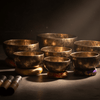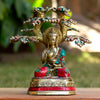1 – GODS – The Highest Order
The gods (déva), during remarkably long lives, enjoy the happiness of all things. Their affliction comes at the edge of their lives when they are denied by their community and a flash into the world in which they will be reborn which, via definition, will be a more secondary world, having exhausted their merits bathing for centuries in more indulgences than we may dream of.
The pride connected with huge amounts of positive karma can direct you to be re-born in this section of the Wheel of Life.
2 – THE TITANS – Samsara at work
The Titans (assoura) or demi-divine beings are amazing creatures whose fundamental occupation and enduring is to be continually occupied with clashes and contentions.
Rumors from far and wide suggest that the Tree of Life fills in this world, yet the Fruit of Eternal Life which it bears, falls into the World of the Gods. Which are the nature behind their Jealousy and Constant clash with the Gods.
Envy related with some great karma prompts resurrection in this domain of the Wheel of Life.
3 – HUMANS – Our Existence
People (mansuya)suffer basically from birth, maturing, affliction, and passing, yet additionally from numerous different sufferings and challenges. Dissimilar to different universes it is feasible to get profound education in this world, which isn't the situation for different universes.
Want, combined with an unrivaled limit with regards to great karma as opposed to terrible karma, prompts resurrection in this domain of the wheel of life.
4 – ANIMALS – Everyday Samsara
Creatures (tiryanca) experience the ill effects of cold, hunger, infection, barbarianism, subjugation, and abuse by people. They likewise experience the ill effects of extremely restricted insight.
The negative karma that is related to obliviousness prompts resurrection in the creative universe of Samsara.
5 – HUNGRY SPIRITS – The opening of “hell”
The ravenous spirits experience the ill effects of an appetite and thirst that can never be extinguished or fulfilled by the rare events they discover food or water.
Covetousness and the negative karma related to it will prompt resurrection in this domain of the Wheel of Life.
6 – THE DAMNED – Hell in Buddhism
The condemned (Naraka) are the individuals who live in Buddhist heck, universes of extraordinary enduring in which life is amazingly long. The creatures that wind up there are liable to torment with fire and ice and various sufferings.
Negative karma related with disdain will prompt resurrection in Samsara damnation.
A BUDDHA FOR EACH WORLD: SAMSARA
The comprehension of the wheel of life or Samsara as some like to call it, would not be finished without this crucial snippet of data: The human world, because of harmony among great and wickedness, makes profound practice simpler to achieve and subsequently is supported by the Buddhas. In any case, it isn't because they favor our (human) world that they don't meditate in every one of the universes to diminish the weights of enduring that all creatures convey and if conceivable lead them to the way of freedom (illumination). There are 6 gatherings of Buddhas that act in every world :
-
INDRA “Offerings a Hundredfold” – white in color, for the Gods
-
VEMACITRA “Splendid Robe” – green in color, for the Titans.
-
SHAKYASIMHA “Lion of the Shakyas” – yellow in color, for the Human World.
-
DHRUVASIMHA “Unmovable Lion” – green in color, for the Animal World.
-
JVALAMUKHA “Flamboyant Mouth” – red in color, for the world of the Hungry Spirits.
-
DHARMARAJA “King of Dharma” – black in color, for Hell.
As you can see from the rundown over, no world is neglected and illumination is conceivable from any of the universes, yet as clarified over the harmony among great and malicious found in our reality, permits us a bigger ability to get away from the holds of Yama, maybe after numerous long stretches of reflection, different Siddhis, perpetual liberality, and satisfaction.






